5.4 Anatomy of the Urinary System
The urinary (YŪR-ĭ-nĕr-ē) system, also referred to as the renal (RĒ-năl) system or urinary tract (YŪR-ĭ-nĕr-ē trăkt), consists of the kidneys, ureters, bladder, and urethra. The kidneys form urine and perform other functions attributed to the urinary system. The ureters carry the urine away from kidneys to the urinary bladder, where it is stored until it is expelled during urination. The urethra carries the urine from the urinary bladder to the outside the body during urination.[1] See Figure 5.1[2] for an illustration of the male urinary system.
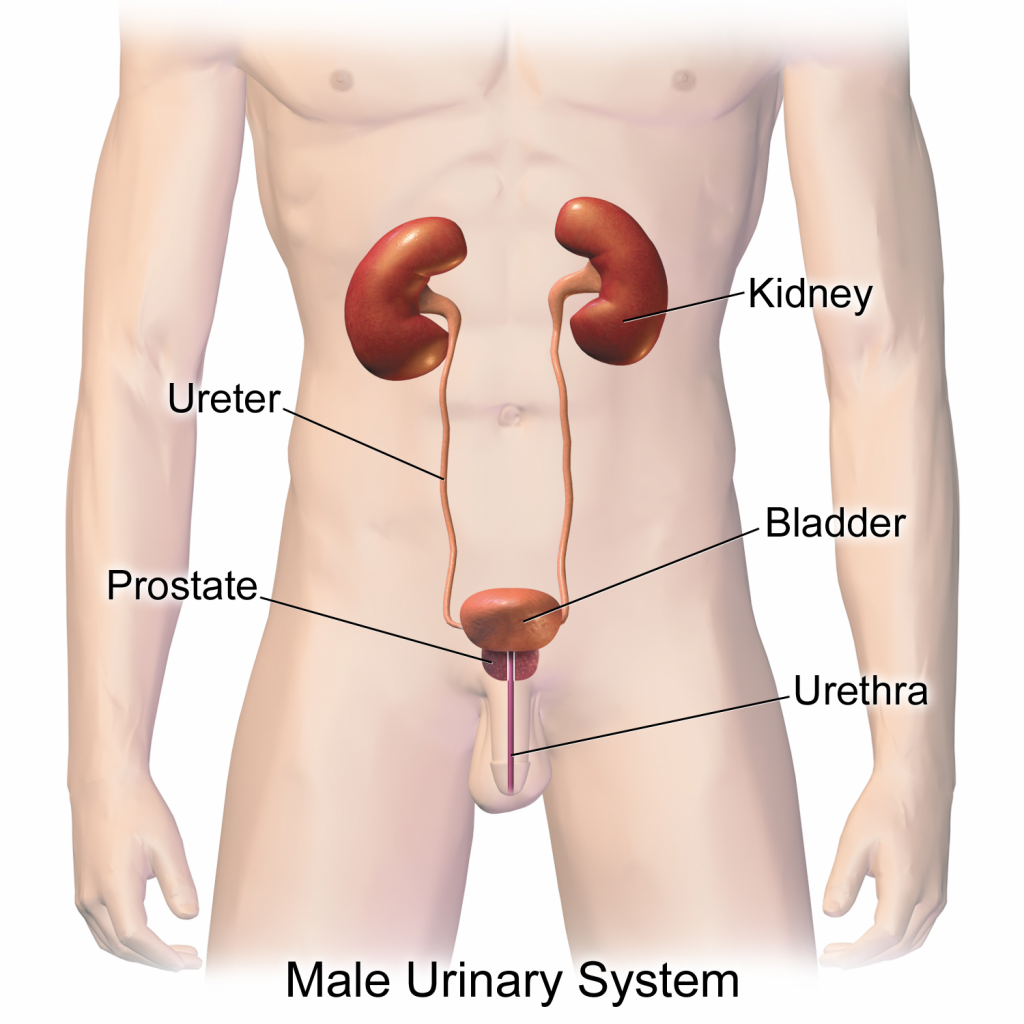
Kidneys
The kidneys (KĬD-nēz) are a pair of organs that filters waste from the blood and produces urine. Kidneys lie on either side of the spine behind the abdominal cavity, well protected by muscle, fat, and ribs. They are roughly the size of your fist. The male kidneys are typically a bit larger than the female kidneys. The kidneys are well-vascularized, receiving about 25 percent of the blood pumped out of the heart with each heartbeat.[3] Figure 5.2[4] shows the location of the kidneys.
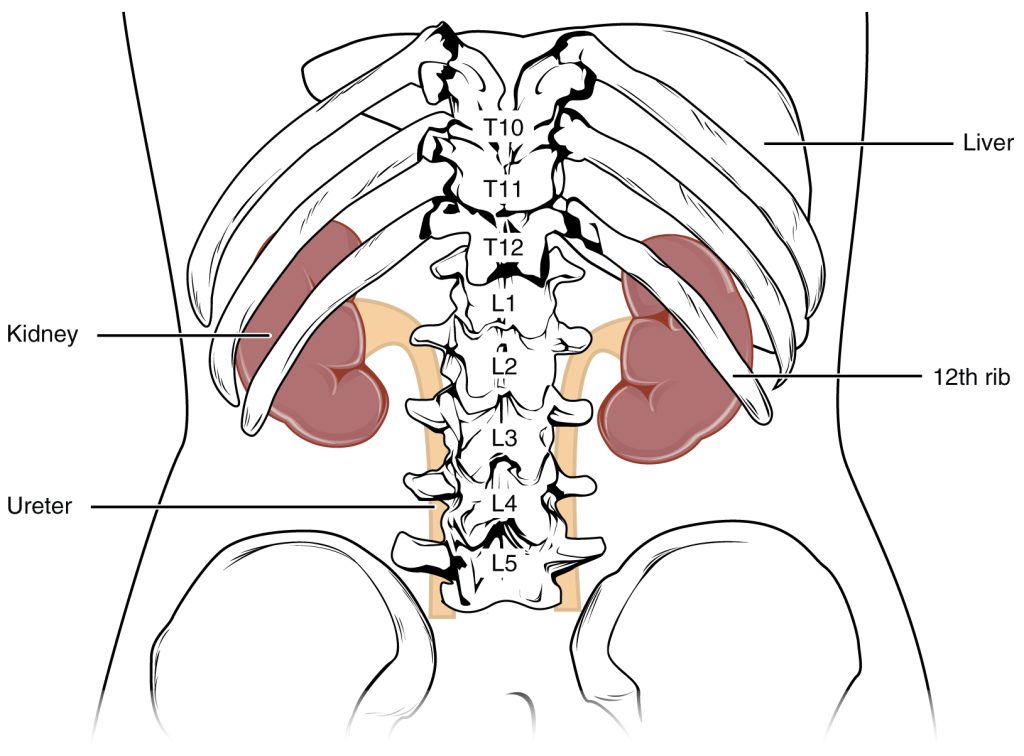
The outer region of the kidney is called the renal cortex, and the inner region is called the renal medulla. See Figure 5.3[5] for an illustration of the internal structures of the kidney. The renal hilum is the entry and exit site for vessels, nerves, and ureters. The renal arteries (colored red) come directly from the descending aorta, and the renal veins (colored blue) return cleansed blood to the inferior vena cava.[6]
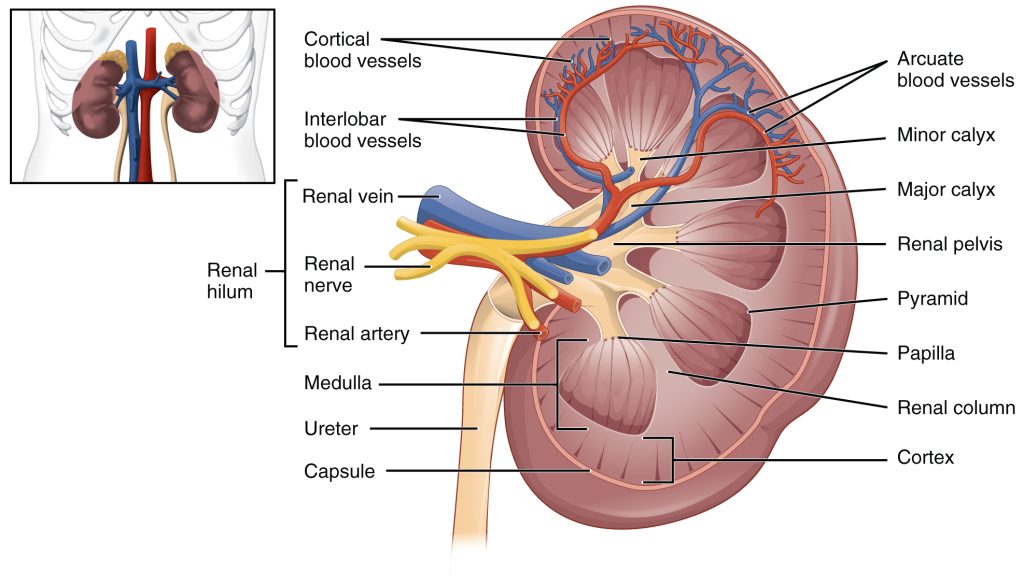
Arterioles and Nephrons
The renal artery branches into small arteries called afferent arterioles that bring blood to the nephron. See Figure 5.4[7] for an illustration of blood flow from the renal artery to the afferent arterioles to a nephron. The nephron (NĔF-rŏn) is the functional unit of the kidney and filters the blood, removes wastes, and balances fluid and electrolyte levels. Afferent arterioles service about 1.3 million nephrons in each kidney.[8]
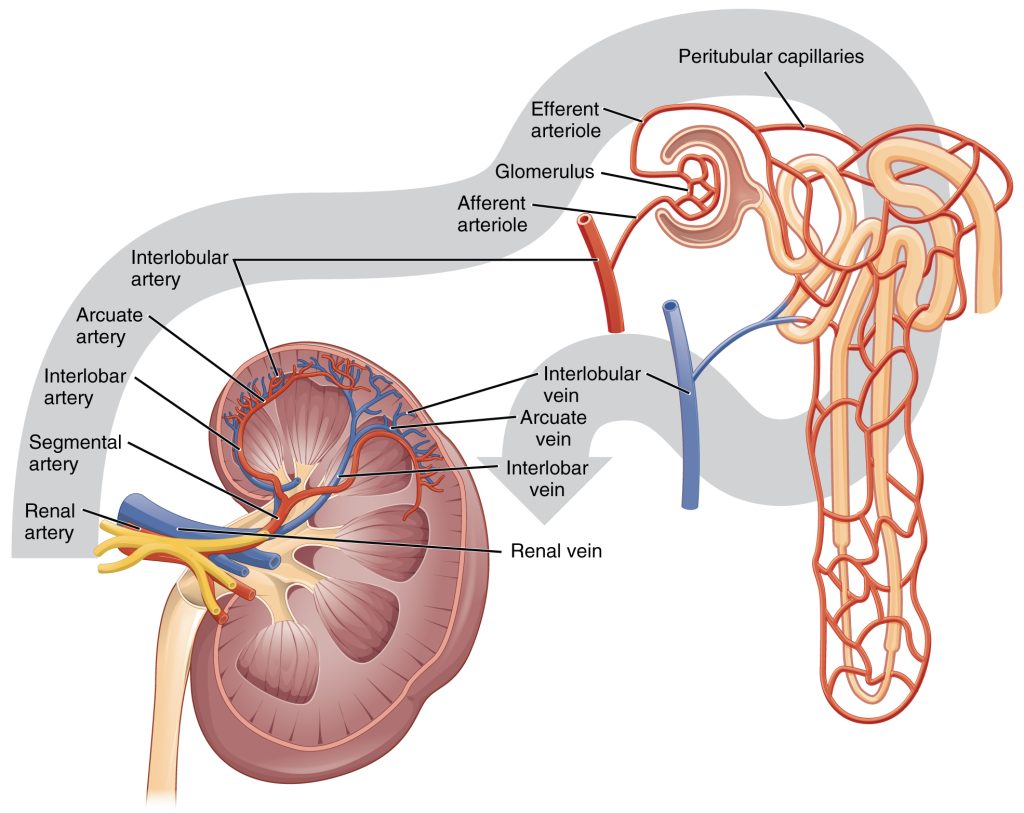
A nephron has two main sections called a renal corpuscle and a renal tubule. The renal corpuscle consists of a cluster of high-pressure capillaries, called the glomerulus (glō-MĔR-ū-lŭs), surrounded by a glomerular capsule. See Figure 5.5[9] for an illustration of blood flow through the nephron. The capillaries in the glomerulus initially filter the blood to create a filtrate, which is mostly water, amino acids, glucose, and ions. The filtrate then flows through the renal tubule beginning with the proximal tubule, a long loop-like structure called the nephron loop (or loop of Henle), and the distal convoluted tubule. Different portions of the renal tubule have different permeabilities for solutes and water, and efferent arterioles recover most of the water and electrolytes and return them back into the circulation. The remaining wastes pass as urine from the nephrons into collecting ducts and eventually into the ureters for elimination from the body.[10]
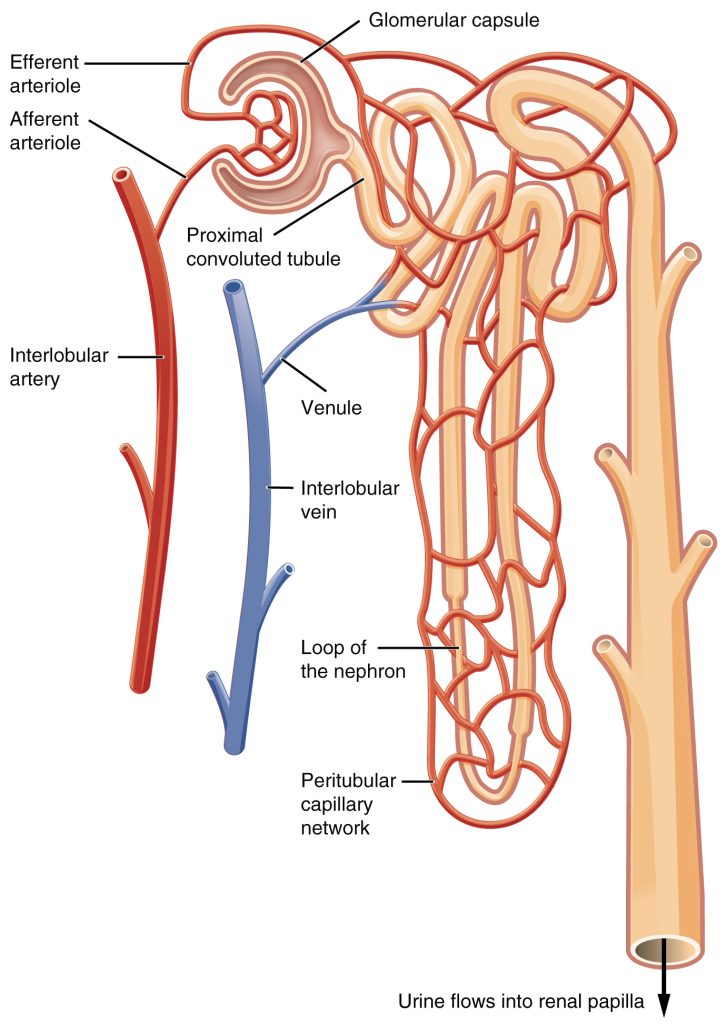
Ureters
As urine is formed, it drains into the calyces of the kidney, which merge to form the funnel-shaped renal pelvis in the hilum of each kidney. The hilum narrows to become the ureter (YŪR-ĕ-tĕr). As urine passes through the ureter, it does not passively drain into the bladder but rather is propelled by wave-like contractions called peristalsis. The ureters are approximately 30 cm long.[11]
Bladder
The bladder (blăd-ĕr) collects urine from both ureters. View Figure 5.6[12] to see a cross-section of the bladder. The bladder lies anterior to the uterus in females, posterior to the pubic bone, and anterior to the rectum. During late pregnancy, bladder capacity is reduced due to compression by the enlarging uterus, resulting in increased frequency of urination. In males, the anatomy is similar, minus the uterus, with the addition of the prostate inferior to the bladder. The bladder can project into the abdomen when it becomes distended (dis-TEN-ded) or stretched out with urine.[13]
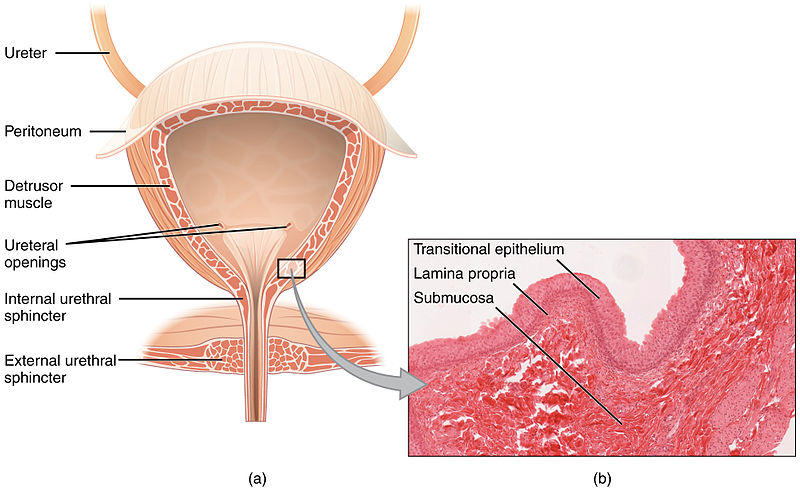
Urethra
The urethra (yū-RĒ-thră) transports urine from the bladder to the outside of the body during urination. The urethra is the only urologic organ that is significantly different between males and females; all other urine transport structures are identical. In females, the urethra is shorter, which causes an increased risk for urinary tract infections.[14] See Figure 5.7[15] for a comparison of the female and male urinary systems.
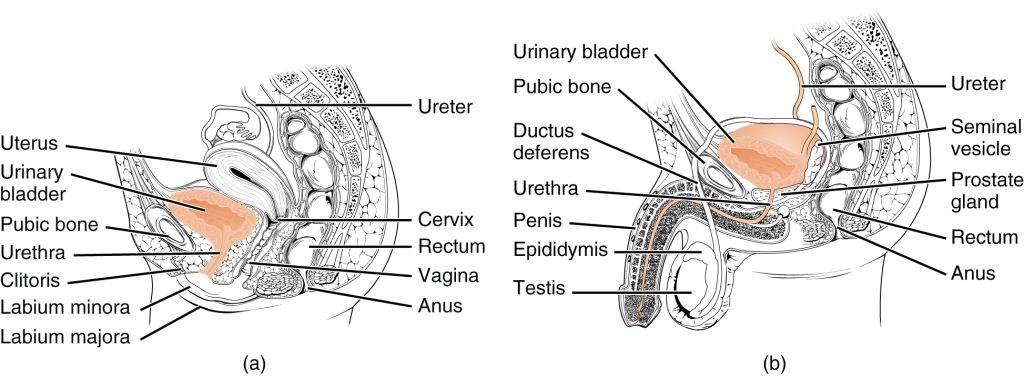
Urination
Urinate (YŪR-ĭ-nāt) means to pass urine, also referred to as void (voyd) or micturate (MĬK-tū-rāt). A healthy adult with normal functioning kidneys produces an average of 800-2,000 mL of urine per day, depending on their fluid intake and other physiological processes. The adult bladder typically holds about 360-480 mL of urine.[16]
Urination is regulated by the internal and external urinary sphincters (SFĬNK-tĕrz), circular muscles constricting an orifice (opening). As the bladder fills to about 150 mL (5 ounces), it sends signals to the brain to create an urge to urinate. The internal and external urinary sphincters work together to close off the urethra to keep urine in the bladder until the brain sends signals it is time to urinate. As the bladder continues to fill, subsequent urges become harder to ignore. If voluntary voiding does not occur and the bladder overfills, voluntary control fails, resulting in urinary incontinence (ĭn-KŎN-tĭ-nĕns).[17]
Frequency of urination depends on how quickly the kidneys produce urine and how much urine a person’s bladder can comfortably hold. Normal urine is typically clear or pale to light yellow in color with little to no odor. However, some foods (like asparagus) or medications (such as antibiotics) may change the smell or color of urine.[18]
In infants, the reflex to urinate is active, but as toddlers mature, they learn how to override the reflex and control the external sphincter, thus delaying voiding until it is appropriate to do so (commonly referred to as “potty training”).[19]
- National Institute of Diabetes and Digestive and Kidney Diseases. (2020, June). The urinary tract & how it works. National Institutes of Health. https://www.niddk.nih.gov/health-information/urologic-diseases/urinary-tract-how-it-works ↵
- “Urinary_System_(Male).png” by BruceBlaus is licensed under CC BY-SA 4.0 ↵
- This work is a derivative of Anatomy and Physiology by OpenStax licensed under CC BY 4.0. Access for free at https://openstax.org/books/anatomy-and-physiology/pages/1-introduction ↵
- “2608_Kidney_Position_in_Abdomen.jpg” by OpenStax College is licensed under CC BY 3.0 ↵
- “2610_The_Kidney.jpg” by OpenStax College is licensed under CC BY 3.0 ↵
- This work is a derivative of Anatomy and Physiology by OpenStax licensed under CC BY 4.0. Access for free at https://openstax.org/books/anatomy-and-physiology/pages/1-introduction ↵
- “2612_Blood_Flow_in_the_Kidneys.jpg” by OpenStax College is licensed under CC BY 3.0 ↵
- This work is a derivative of Anatomy and Physiology by OpenStax licensed under CC BY 4.0. Access for free at https://openstax.org/books/anatomy-and-physiology/pages/1-introduction ↵
- “2611_Blood_Flow_in_the_Nephron.jpg” by OpenStax College is licensed under CC BY 3.0 ↵
- This work is a derivative of Anatomy and Physiology by OpenStax licensed under CC BY 4.0. Access for free at https://openstax.org/books/anatomy-and-physiology/pages/1-introduction ↵
- This work is a derivative of Anatomy and Physiology by OpenStax licensed under CC BY 4.0. Access for free at https://openstax.org/books/anatomy-and-physiology/pages/1-introduction ↵
- “2605_The_Bladder.jpg” by OpenStax College is licensed under CC BY 3.0 ↵
- This work is a derivative of Anatomy and Physiology by OpenStax licensed under CC BY 4.0. Access for free at https://openstax.org/books/anatomy-and-physiology/pages/1-introduction ↵
- This work is a derivative of Anatomy and Physiology by OpenStax licensed under CC BY 4.0. Access for free at https://openstax.org/books/anatomy-and-physiology/pages/1-introduction ↵
- “Female_and_Male_Urethra.jpg” by OpexStax College is licensed under CC BY 4.0 Access for free at https://openstax.org/books/anatomy-and-physiology-2e/pages/1-introduction ↵
- This work is a derivative of Anatomy and Physiology by OpenStax licensed under CC BY 4.0. Access for free at https://openstax.org/books/anatomy-and-physiology/pages/1-introduction ↵
- This work is a derivative of Anatomy and Physiology by OpenStax licensed under CC BY 4.0. Access for free at https://openstax.org/books/anatomy-and-physiology/pages/1-introduction ↵
- National Institute of Diabetes and Digestive and Kidney Diseases. (2020, June). The urinary tract & how it works. National Institutes of Health. https://www.niddk.nih.gov/health-information/urologic-diseases/urinary-tract-how-it-works ↵
- This work is a derivative of Anatomy and Physiology by OpenStax licensed under CC BY 4.0. Access for free at https://openstax.org/books/anatomy-and-physiology/pages/1-introduction ↵

